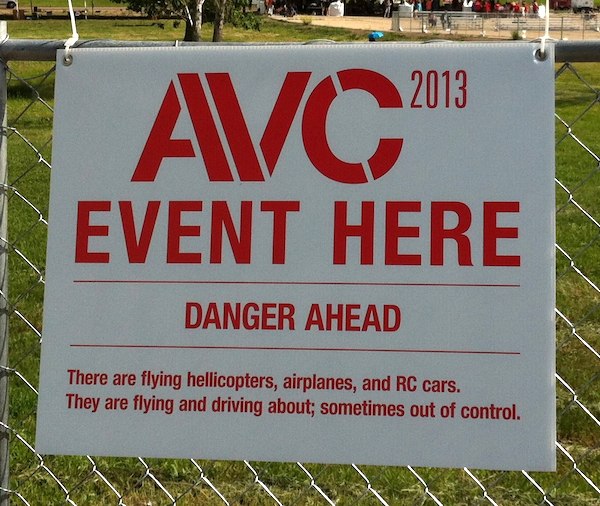
Robohub.org
SparkFun AVC 2013

Most robotics hobbyists will be familiar with the name SparkFun, associating it with an electronics and robotics parts and kits supply house, located in Boulder, Colorado, and perhaps also with the instructional videos they publish on their YouTube channel.
The SparkFun Autonomous Vehicle Competition (AVC) for 2013 took place Saturday, June 8th, on a strip of land separating Boulder Reservoir from a private lake to the south. The event site was fenced in, encompassing what I’d guess to be about ten acres, with an adjacent area of water of similar dimensions marked off by buoys for the aerial course. There was also a fence around the ground course, to separate the vehicles from the crowd.
Held annually since 2009, this is the first time that AVC has not been held on SparkFun’s home turf, located just across CO 119 from the reservoir. The weather for AVC 2013 was nearly ideal, and very comfortable, with only a light breeze, moderate temperature, about 50% cloud cover, but only the occasional drop of rain, and dewpoint about 40°F lower than the temperature. Barometric pressure was on the low side (29.98 in. Hg or lower, corrected to sea level), which may help account for some of the troubles in the aerial competition.
The ambiance was reminiscent of a country fair, with three food trucks on site, a sideshow or two, and raffle drawings based on a variety of parameters (instances of vehicles running into a barrel, number of vehicular collisions, etc.) during particular runs in the ground competition. There was music, intermittent sunshine on fresh green grass, a sandy beach and water that looked swimmable. And not least, the announcers for both ground and aerial competitions had comfortable control of their respective sound-spaces, keeping running commentaries going without resorting to elongated vowels or repetition.
As explained by Robert Cowan in an introductory video published two months prior to the event, featured on the 2013 event website, the move to the reservoir is not the only change from previous years. Instead of the fastest time determining the winner, a point system incorporating bonus points for accomplishment of specific tasks while negotiating the course was used.
On the ground, contestants started out with 300 points, from which one point was deducted for each second required to complete the course. Bonus points were awarded for each corner passed, for going through a hoop, and for jumping a ramp. In the air, contestants started out with 600 points, again with one point deducted for each second used. Aerial bonus points were awarded for crossing over the tip of a peninsula, for dropping a tennis ball onto that peninsula, for passing under a twenty-foot high ‘wicket’, for an autonomous landing, and for an autonomous landing within a restricted area. Most of the aerial course was over water.
In the aerial competition, they could have added a bonus for becoming airborne and establishing stable autonomous control, as failing to accomplish one or the other was a frequent occurrence. Perhaps teams from lower elevations underestimated how much difference a few thousand feet can make.
For the ground competition, vehicles were divided into one of four categories: Micro/PBR (less than $350 total spent, or small enough to fit into box that’s 10″x6″x4″), Doping ($1k+ or 25lbs+), Non-traditional locomotion (walker, pogostick, Segway-like balancing, motorized hamster ball, etc.) and Peloton (anything that didn’t fit in one of the other classes). There was also a student class (any robot that is 80% designed and built by high school or younger students), for which any student-built robot qualified, regardless of category. For the aerial competition there was no division into categories.
Autonomous operation is the key ingredient of this event, and overall I was very impressed with the results. For ground vehicles, the only human intervention allowed was at the starting line, to set the vehicle in motion. For aerial vehicles there was a similar requirement, except that manual landing was allowed, with autonomous landing constituting a bonus. While not altogether unique, this combination of autonomous operation and an open-air setting is rare, and precautions were in evidence everywhere, beginning with the waiver to be signed as a condition of entry at the ticket booth.

This sign was no idle warning. By the middle of the day, I’d seen one aerial vehicle rescued from diving into the crowd by a quick thinking operator who took over manual control just in time, another, which failed to get off the ground, taxiing directly toward a young spectator, and prevented from running right into him only because it was precisely centered between two of the posts ringing the parking lot (being used as a start line and landing strip) and its wings were too wide to fit between them. I’d also seen one over-eager ground vehicle go into the infield and do its best to climb a vertical object of some sort, and another, built from a full-sized go-cart, and therefore heavy enough to be dangerous, pin itself against the fence. There was a medical tent, staffed by paramedics, and an ambulance on standby, just in case.
While such risks go with the state of the art of autonomous robotics, the precautions proved adequate, and SparkFun is to be congratulated for a very professionally produced event.
Lest I leave you with the impression that the courses and bonus challenges were too much for the poor robots, I should add that several of the aerial contestants not only completed the course but racked up all of the bonus points. In the ground vehicle competition, more than a few entrants also finished the course, although I don’t know whether any of them also got all of the bonus points. For detailed results of the competitions, keep an eye on the event website, and on SparkFun’s YouTube channel.
tags: Competition-Challenge, Event, review, SparkFun


